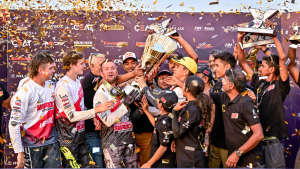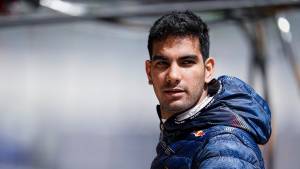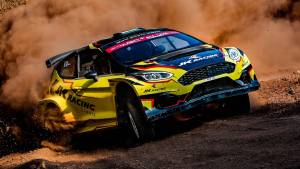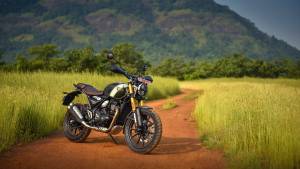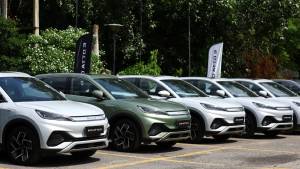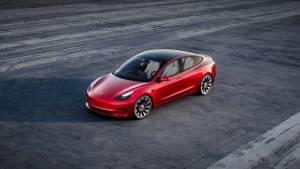Motorsport memories: Nazir Hoosein
Over the years my trips to Liberty Cinema have become something of an annual affair. I'd give my name to the guard downstairs, be escorted up to the first floor of the building ensconced in an elevator almost made entirely of Canadian Cedarwood, step out onto the red carpeted floor and be transported back in time. This, not only because the art deco building looked exactly as it did back in the day when the doors of the cinema were first flung open in 1949. It was also because, within a little office in the building, surrounded by motorsport books and journals of every kind, Nazir Hoosein would sit a veritable encyclopaedia on the subject of the sport. And with the merest hint of a question from me, he'd launch off into a tale, more often than not, delivering the entire story in one go. A chronological account, suitably punctuated with facts, figures and dates, and appropriately peppered with anecdotes. It was a treat to listen to him. But while he'd regaled me with stories aplenty about motorsport events, and motorsport personalities, and I had turned in askance to that encyclopaedic brain to clarify facts about the history of Indian motorsport, I hadn't managed to sit down with him and have a chat about his own motorsport memories. And so, I finally did.
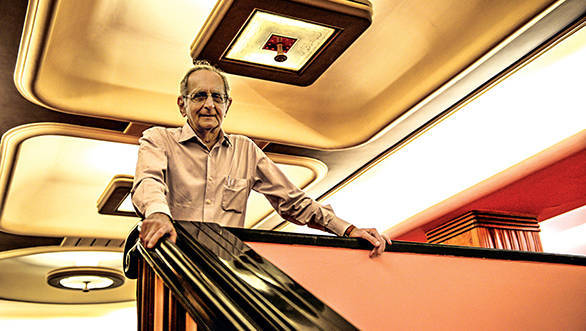 Nazir Hoosein at the Liberty Cinema - just as sprightly as he was when he started racing!
Nazir Hoosein at the Liberty Cinema - just as sprightly as he was when he started racing!
"I never grew up!," Nazir Hoosein, all of 75 years old, says to me with a merry smile, telling me how all children at some point have pedal cars, and that he merely replaced pedal power with a few horses 'neath the hood. Of course, it helped that on his sixteenth birthday, he was presented his father's Jaguar XK120, a car that was once raced, and won trophies too, at the Juhu races piloted by a gentleman named Peter Heilbron. And with access to a set of four wheels of his own, things only grew. "It was a simpler time, back then," Hoosein tells me. The security measures that we find today, did not exist back then, and so it was possible to drive right up to the Tansa Dam and to various other places in and around Mumbai. The more miles that went by, the more resolute he became that he simply needed to open a garage of his own.
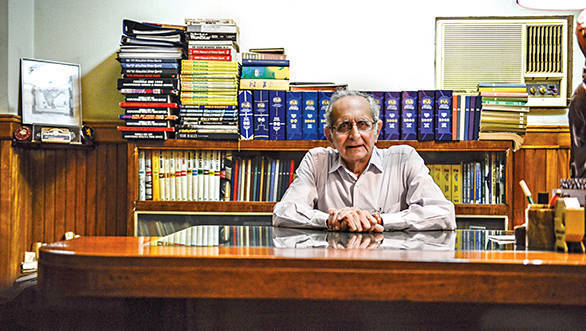 The encyclopaedic knowledge of motorsport came from intense studying - there are motorsport books and journals of every kind in Hoosein's office at the Liberty Building
The encyclopaedic knowledge of motorsport came from intense studying - there are motorsport books and journals of every kind in Hoosein's office at the Liberty Building
Never one to go into a situation unprepared, Hoosein began reading books about everything to do with cars. He also began to work with Adarbad Sethna who owned the popular A1 Garage in Mumbai. You see, Hoosein, even back then, was of the opinion that in order to get truly good at something, you needed to be willing to get your hands dirty. He certainly did, working on the rather tricky project that was the restoration of a Hispano Suiza J12, a car that initially came equipped with a V12 engine, which Hoosein fitted with two 6-cylinder Chevrolet engines in order to have it up and running. When the time came to open his own garage, he went to his old schoolmate Mohinder Lalwani, who'd by then finished his engineering from the Banaras Hindu University, and together they started the Alpha Garage.
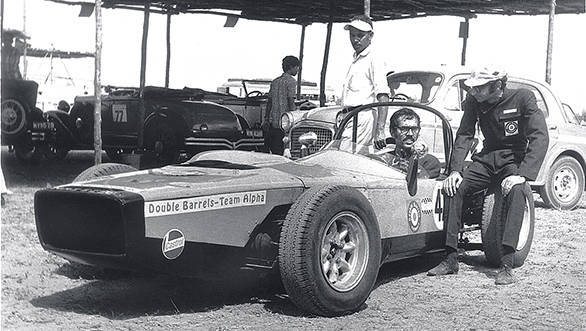 Hoosein has a quick conversation with his partner Mohinder Lalwani before the latter heads out for a race in the Double Barrels-Team Alpha special
Hoosein has a quick conversation with his partner Mohinder Lalwani before the latter heads out for a race in the Double Barrels-Team Alpha special
The transition from garage to competition was but obvious. "Oh, we were a little late!," Hoosein exclaims. After all, he'd only managed to start racing at the ripe old age of 29. But in true Hoosein fashion, he went about it with meticulous amounts of effort. The first stop was Brands Hatch to train himself in the art of motorsport. "After the first day, I was a half a second within the lap record, and I realised I was fast. Naturally fast!" There was no question about not going into racing after that, having had his skills so nicely honed by Toni Lanfranchi, his racing instructor. And, like any good racecar driver, he decided to stay on at Brands Hatch for the next two weeks, racing until he went broke.
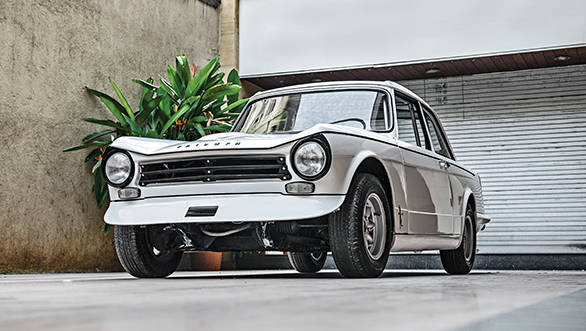 The Triumph Herald 13/60 in which Hoosein, Lalwani and Suresh Naik won the Asian Highway Rally
The Triumph Herald 13/60 in which Hoosein, Lalwani and Suresh Naik won the Asian Highway Rally
The adventures continued, with him and Lalwani tweaking, whittling, porting, boring and outright modifying road-going Heralds to try and convert them into those "Specials" that were raced at Sholavaram. "Can you hazard a guess as to the number of people who'd show up to watch the races?," Hoosein asks, with that same twinkle in his eye. Well, I've heard that the figure was something around 50,000 people, and so I answer. "It was! It was 50,000 people," he exclaims, telling me that the number was obtained from the man who'd put up the stands. He would put up stands for 50,000 people, and they were always full. "It was bigger than cricket back then," he says.
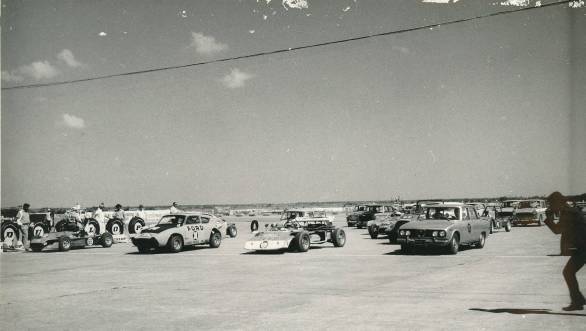 The Alpha Motor Company special on pole position driven by Hoosein to the extreme left, with the Arpico special from Sri Lanka driven by David Pieres next to it, followed by the special of M K Gondal built by the late Adarbad Sethna, and an Alfa Romeo to the extreme right
The Alpha Motor Company special on pole position driven by Hoosein to the extreme left, with the Arpico special from Sri Lanka driven by David Pieres next to it, followed by the special of M K Gondal built by the late Adarbad Sethna, and an Alfa Romeo to the extreme right
I watch and listen as Hoosein looks visibly delighted to be reliving those memories of racing back at Sholavaram. He tells me of names that have now gone down in history as legendary. AD Jayaram from Bangalore, Dr Cesare Rossi from Italy, David Pieris from Ceylon, the Maharaja of Gondal It was a time that you think of, not in colour, but in black and white, or in sepia tones and bromide prints.
"Oh, I remember our first race at Sholavaram. We were up against Gondal in his Buick, and our Herald was very fast." In fact, it was so much of a threat that the Maharaja had had as many parts on his car changed as he possibly could, converting them to weight-saving aluminium in the hopes that it would help him catch the Double Barrels Team Alpha Special. Well, it didn't. "But it was a different time back then, we had fierce competition," he sighs rather wistfully.
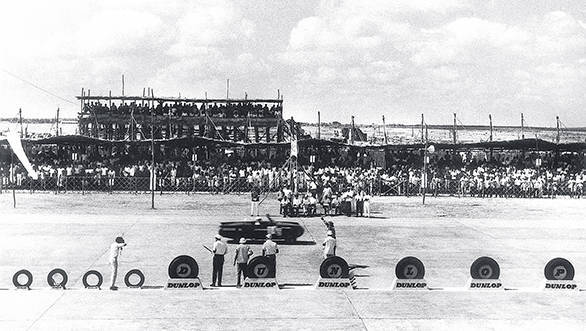 The packed grandstands at Sholavaram - 50,000 strong!
The packed grandstands at Sholavaram - 50,000 strong!
There were other memorable races in the DBTA Special. They shipped the car over to Sri Lanka for the races in 1974, where they went up against Pieris. It is a race Hoosein ranks as his most memorable. They went into the final corner of the final lap, Hoosein in the DBTA sparring with Pieris in the Ford Special. "Well, he didn't make it, but I did." And thus Hoosein came to be the Sri Lankan National Champion, following it up a year later by taking the title in India as well.
But in all the tales that he tells me, there's one thing that always stands out. The fact that he keeps reminding me that it was a different time back then. A time when people were nicer. A time when a fellow competitor wouldn't hesitate to help a rival by loaning him a much needed tool. Or when immigration officials in one country would clear a rally car on the border in a minute and a half flat, only saying, "Now you tell your officials to clear my boys in the same time." It was an era when a gentleman's word held good. Hoosein recounts to me the time when at the Juhu races he was told by the man who was putting up the stands that there were likely to be more people than the stands could accommodate. And when he had refused to add another stand, owing to the fact that the costs were high, the man had told him he'd make one anyway. Only if they filled up would Hoosein have to pay him. "Well, they didn't fill up so I didn't pay him!," he laughs.
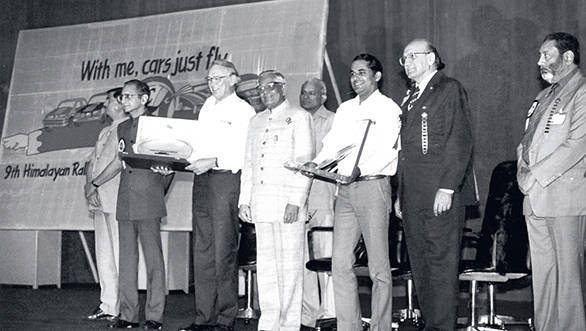 Hoosein with President Venkataraman at the prize-giving ceremony of the Himalayan Rally in 1988
Hoosein with President Venkataraman at the prize-giving ceremony of the Himalayan Rally in 1988
When his focus shifted to organising legendary events like the Himalayan Rally though, Hoosein stopped racing, transferring his attention and precision to ensuring world class events ran in the country. In fact so precise was he that he wouldn't allow the then Sports Minister to delay the end of the Himalayan Rally because she was late to flag in the first car. "She flagged in the fifth car and told me 'We'll see how you run again.' So I had to go to the President of the country, who was our patron, to sort out the Sports Minister," he chuckles before saying, "Well it was a long time ago, so I can say it now."
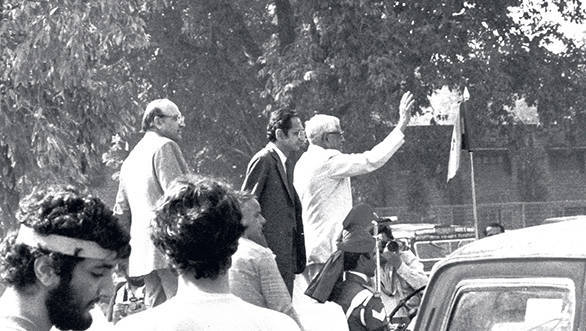 And here with President Venkataraman at the start of the Himalayan Rally in 1984
And here with President Venkataraman at the start of the Himalayan Rally in 1984
There are more tales that Hoosein stored away in his razor sharp mind. Tales of how it was a time of split second decisions, that needed to be accurate, when he was the vice president and one of the four permanent stewards of the FIA. A time when he needed to remember rules and regulations and have them at the tip of his tongue at any given point of time. Something that he achieved by studying, in his own words, "all the time". "It was an interesting time," he says to me, his voice trailing off to a near whisper.
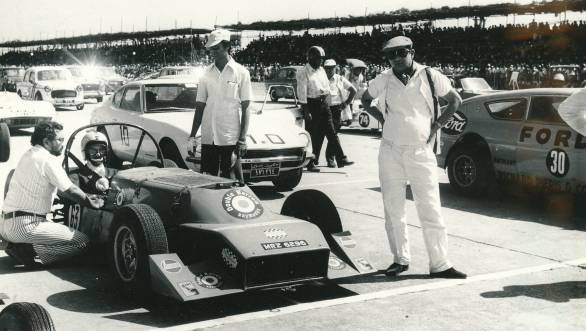 The late Ajaypat Singhania gives Hoosein a final set of instructions before he heads out onto track in the Raymond Woollen Mills sponsored car
The late Ajaypat Singhania gives Hoosein a final set of instructions before he heads out onto track in the Raymond Woollen Mills sponsored car
And that's when it occurs to me that every occasion I speak to Nazir Hoosein, the words 'time' and 'change' come up often. Time being different back then. Times changing today. For better or for worse, we speak of change as a constant. But in stark contrast to the rest of the world, tucked away in that little corner of Mumbai, is a building that stands rock solid, refusing to be cowed down by whatever it is that springs up beside it. And within it, a man who somehow manages to stay as constant, appearing for all intents and purposes not to slow down. "I still drive fast," Hoosein says to me with a smile. "I mean, I enjoy it."
And it's this that gets me thinking. In a world that changes so constantly, it's nice to know there are some things, just some things, that never change.
Photos courtesy: Himalayan Rally Association, Nazir Hoosein, and Lalwani Family Archives.
Related Stories
Top Stories
Latest Videos
Most Popular
- Budget Sportbike Showdown: Kawasaki Ninja 500 vs Aprilia RS 457 vs Yamaha YZF-R3
- Mumbai-Pune Expressway speed restrictions updated
- 2014 Triumph Daytona 675 vs 2024 Kawasaki ZX6R - A Decade of Evolution in Supersport Motorcycles
- 2024 Hyundai Creta vs Toyota Urban Cruiser Hyryder vs Skoda Kushaq comparison review - the hype is real?
- Nissan Magnite EZ-Shift review - is the AMT any good?
